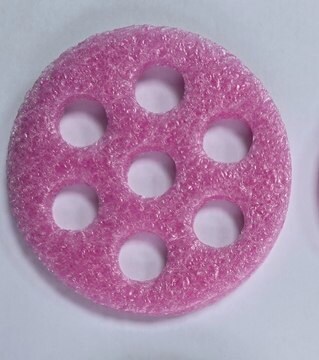Most applications will require pre-treatment prior to dialysis. As mentioned in the 'DESCRIPTION' section, under 'Preparation Note', for the removal of glycerol included as a humectant, wash the tubing in running water for 3-4 hours. To remove any residual sulfur, treat the tubing with a 0.3% (w/v) solution of sodium sulfide at 80°C for 1 minute. Wash with hot water (60°C) for 2 minutes, followed by acidification with a 0.2% (v/v) solution of sulfuric acid, then rinse with hot water to remove the acid. Wetted membranes may be stored in water containing benzoic acid or formaldehyde.
D9777
Dialysis tubing cellulose membrane
avg. flat width 25 mm (1.0 in.)
Synonym(s):
Cellulose dialysis tubing, Dialysis membrane
Select a Size
€186.00
Select a Size
About This Item
€186.00
Recommended Products
avg. diam.
16 mm , when full
avg. flat width
25 mm (1.0 in.)
capacity
~60 mL/ft
Looking for similar products? Visit Product Comparison Guide
Related Categories
General description
Packaging
Quality
Preparation Note
Choose from one of the most recent versions:
Certificates of Analysis (COA)
Don't see the Right Version?
If you require a particular version, you can look up a specific certificate by the Lot or Batch number.
Already Own This Product?
Find documentation for the products that you have recently purchased in the Document Library.
Customers Also Viewed
Related Content
Dialysis Tubing
-
Is this product ready to use?Do I need to boil it or place it into NaHCO3 before I use dialysis tube?
1 answer-
Helpful?
-
-
can it seprate 5 nm gold particle from gold solution
1 answer-
If the particle is larger than the tubing's 14 kDa molecular weight cut-off (MWCO) rating, it should be retained.
Helpful?
-
-
what is the storage temperature of this membrane
1 answer-
This product may be stored at room temperature. For products with no specified storage temperature given on the label or product page, ambient storage may be assumed. Products that require controlled temperature storage, such as refrigeration or freezer conditions, storage temperatures are published on the product label, Certificate of Analysis, and the Safety Data Sheet (SDS).
Helpful?
-
-
Hello, I would like to ask what is the pore size (in nanometres) of the dialysis membrane? (SKU code: D9777 ,Dialysis tubing cellulose membrane, avg. flat width 25 mm (1.0 in.))
1 answer-
The pore size is not determined for this product.
Helpful?
-
-
What are the molecular weight cut-off and the pores size of this dialysis tubing cellulose membrane?
1 answer-
As mentioned on the product detail page, the typical molecular weight cut-off is 14,000. However, this tubing will retain most proteins of molecular weight 12,000 or greater. The pore size has not been determined.
Helpful?
-
Active Filters
Our team of scientists has experience in all areas of research including Life Science, Material Science, Chemical Synthesis, Chromatography, Analytical and many others.
Contact Technical Service







